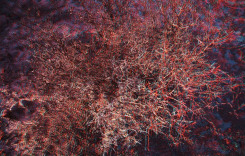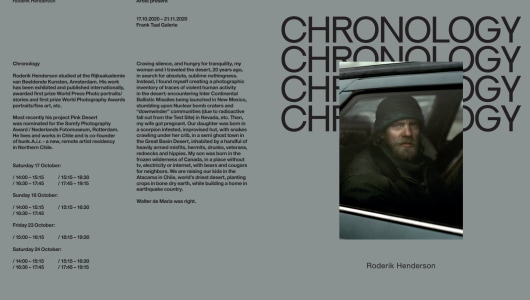Roderik Henderson studied at the Rijksakademie van Beeldende Kunsten, Amsterdam. His work has been exhibited and published internationally, awarded the World Press Photo Portraits/Fine Art First Prize and the Sony World Photography Awards Fine Art First Prize.
Recently, his project Pink Desert was nominated for the Somfy Photography Award/ Nederlands Fotomuseum, Rotterdam.
Roderik Henderson: "In search of the absolute empty landscape, I traveled to the desert 20 years ago. With a trailer, I roamed California, Texas, New Mexico, Arizona, and Utah and ended up in Nevada. There, I built a makeshift hut for me and my family, after which we left again after a few years, looking for a different kind of silence in British Colombia.
Instead of silence and the sublime nothingness I initially sought, I found traces of violent human activity everywhere: the landscape contained bullet-riddled car wrecks and traffic signs or billboards with religiously tinted messages of doom. Long-range missiles flew over with a huge roar and were experimentally launched from New Mexico, heading for an imaginary enemy in Colorado. I found nuclear bomb craters at the Test Site and visited Nevada downwinder communities affected by the fallout. 'Hot' is a photographic inventory in black and white of everything I found there.
'Our Life in a Town of Ghosts' is a photo series about a semi-ghost town in Nevada's Great Basin Desert inhabited by a handful of heavily armed misfits; hermits, veterans, rednecks, and hippies. My daughter was born there in that hut I made, not too safe because of the presence of scorpions and snakes. Later, we left for the frozen wilderness of Canada, in a place without TV, electricity, or internet, with bears and cougars as neighbors. Then my son was born.
There's a rawness to Canada that is inescapable. The impassability of the country and the climate makes it necessary to move around in a car, without which you are lost as a person. Instead of capturing the sublime beauty of Canadian nature, I wanted to capture this rawness, and from that came the series Transvoid, in which I photographed people waiting in their cars in parking lots. With this series, I won the first prize Portraits/ Stories World Press Photo 2010.
The cold and hardships brought us to Chile, where we wanted to start over in the Atacama desert, the driest desert in the world. In one of the most seismographically active areas, I started to build a house by myself without the help of machines. It has become a ten-year project that has changed me as a person and artist. The house I built was deeply rooted in the ground, but I also wanted to penetrate this area in another way. Curious about this barren land, its inhabitants, and their lives, I visited all kinds of mines near Calama and Copiapo. I descended with improvised ladders and via roads that spiraled me deep into the hot earth. I made a series of the copper mining industry called 'Sphere.'
My life and work seem to take place in successive contrasts. It is strange that after the Sphere project, an invitation for a photo assignment would take me to Antarctica, where I would follow the trail of the pioneer Ernest Shackleton. I went from the hottest to the coldest place on Earth. Apart from this assignment, the photos I took during this trip resulted in the book 'No se Asegura Regresso' - (No return guaranteed).
Nevertheless, I returned to Europe a few years ago and built a life in the Netherlands again. I now live in Rotterdam to develop my new photo- and film projects.”
Roderik Henderson
2023
Recently, his project Pink Desert was nominated for the Somfy Photography Award/ Nederlands Fotomuseum, Rotterdam.
Roderik Henderson: "In search of the absolute empty landscape, I traveled to the desert 20 years ago. With a trailer, I roamed California, Texas, New Mexico, Arizona, and Utah and ended up in Nevada. There, I built a makeshift hut for me and my family, after which we left again after a few years, looking for a different kind of silence in British Colombia.
Instead of silence and the sublime nothingness I initially sought, I found traces of violent human activity everywhere: the landscape contained bullet-riddled car wrecks and traffic signs or billboards with religiously tinted messages of doom. Long-range missiles flew over with a huge roar and were experimentally launched from New Mexico, heading for an imaginary enemy in Colorado. I found nuclear bomb craters at the Test Site and visited Nevada downwinder communities affected by the fallout. 'Hot' is a photographic inventory in black and white of everything I found there.
'Our Life in a Town of Ghosts' is a photo series about a semi-ghost town in Nevada's Great Basin Desert inhabited by a handful of heavily armed misfits; hermits, veterans, rednecks, and hippies. My daughter was born there in that hut I made, not too safe because of the presence of scorpions and snakes. Later, we left for the frozen wilderness of Canada, in a place without TV, electricity, or internet, with bears and cougars as neighbors. Then my son was born.
There's a rawness to Canada that is inescapable. The impassability of the country and the climate makes it necessary to move around in a car, without which you are lost as a person. Instead of capturing the sublime beauty of Canadian nature, I wanted to capture this rawness, and from that came the series Transvoid, in which I photographed people waiting in their cars in parking lots. With this series, I won the first prize Portraits/ Stories World Press Photo 2010.
The cold and hardships brought us to Chile, where we wanted to start over in the Atacama desert, the driest desert in the world. In one of the most seismographically active areas, I started to build a house by myself without the help of machines. It has become a ten-year project that has changed me as a person and artist. The house I built was deeply rooted in the ground, but I also wanted to penetrate this area in another way. Curious about this barren land, its inhabitants, and their lives, I visited all kinds of mines near Calama and Copiapo. I descended with improvised ladders and via roads that spiraled me deep into the hot earth. I made a series of the copper mining industry called 'Sphere.'
My life and work seem to take place in successive contrasts. It is strange that after the Sphere project, an invitation for a photo assignment would take me to Antarctica, where I would follow the trail of the pioneer Ernest Shackleton. I went from the hottest to the coldest place on Earth. Apart from this assignment, the photos I took during this trip resulted in the book 'No se Asegura Regresso' - (No return guaranteed).
Nevertheless, I returned to Europe a few years ago and built a life in the Netherlands again. I now live in Rotterdam to develop my new photo- and film projects.”
Roderik Henderson
2023
Artworks
Articles
Media
Highlights
Recommendations
Collections
Shows
Market position
CV
Artworks by Roderik Henderson
Shows
Market position
Roderik Henderson studied at the Rijksakademie van Beeldende Kunsten, Amsterdam. His work has been exhibited and published internationally, awarded first prize World Press Photo portraits/stories and first prize World Photography Awards portraits/fine art.
Most recently his project Pink Desert was nominated for the Somfy Photography Award/ Nederlands Fotomuseum, Rotterdam.
He lives and works in Chile and is co-founder of bunk.A.i.r. - a new, remote artist residency in Northern Chile.
Most recently his project Pink Desert was nominated for the Somfy Photography Award/ Nederlands Fotomuseum, Rotterdam.
He lives and works in Chile and is co-founder of bunk.A.i.r. - a new, remote artist residency in Northern Chile.
Free Magazine Subscription
Articles, interviews, shows & events. Delivered to your mailbox weekly.
















